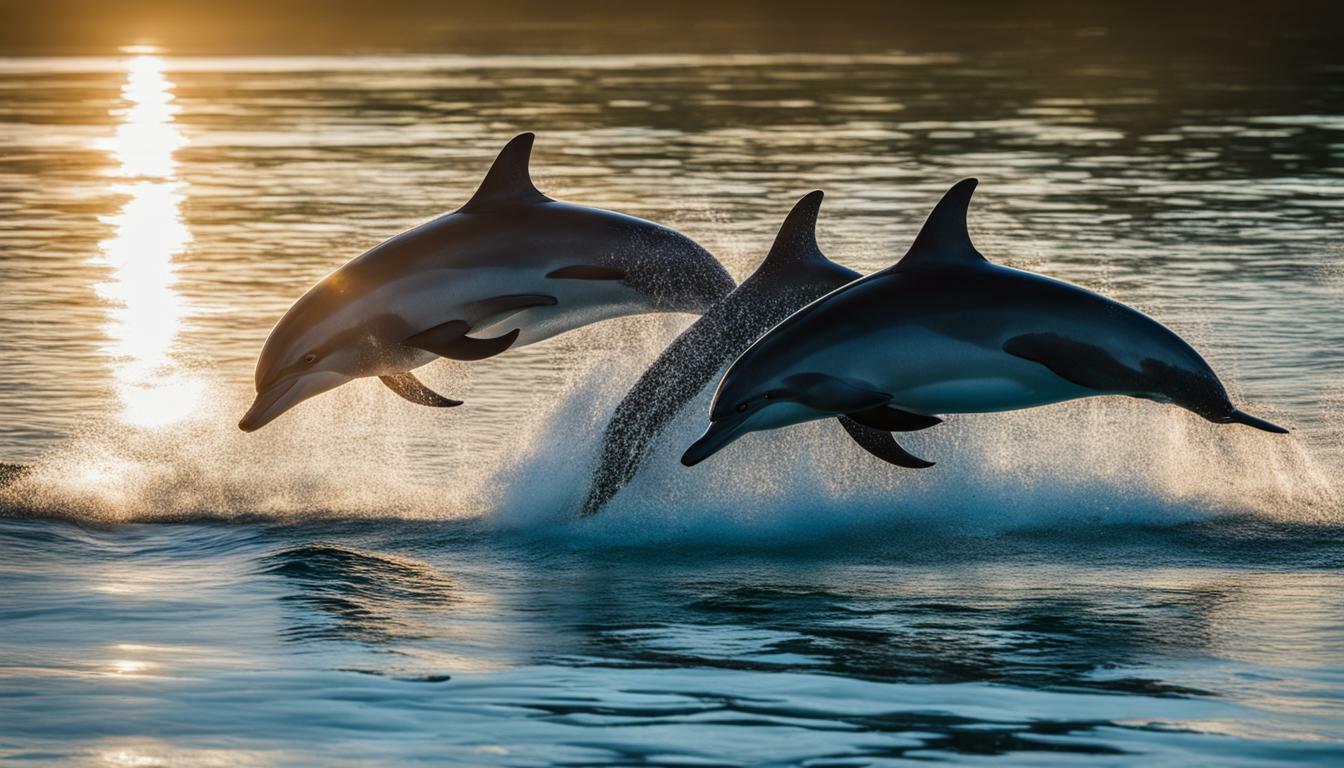Dolphins, known for their intelligence and social nature, exhibit complex social behavior and dynamics that captivate researchers and enthusiasts alike. In the waters of Shark Bay, Australia, bottlenose dolphins live in a large, unbounded society with a unique fission-fusion grouping pattern. These remarkable creatures develop social strategies that involve recognizing a vast number of individuals and understanding their relationships with others.
Male dolphins in Shark Bay engage in 2-3 levels of shifting alliances, forming intricate networks of social connections. They rely on gentle contact behaviors like petting to mediate these alliance relationships. Synchrony also plays a vital role in their affiliative interactions.
The evolution of a large brain in dolphins is thought to be driven by the need for social intelligence in the context of shifting alliances. Due to the size and open nature of their society, dolphins in Shark Bay face relationship uncertainty. Their dynamic social structure and sophisticated communication methods allow them to adapt and navigate through these challenges.
Furthermore, dolphins in different environments demonstrate fascinating diving behavior. For example, offshore bottlenose dolphins in deep waters near oceanic islands, such as the Bermuda Pedestal, exhibit a diel dive cycle. They venture into deeper waters at night, taking advantage of the vertical migration of mesopelagic prey. During the day, their dives are shallow and of shorter duration. This modulation of diving behavior is a strategic response to changes in prey distribution and availability.
By studying these remarkable creatures, we gain valuable insights into their social behavior and diving capabilities. The intricate social structures and communication methods of dolphins continue to astound and captivate us, shedding light on the complex underwater world they inhabit.
Understanding Dolphin Societies: Complex Relationships and Alliances
Dolphin societies are characterized by complex relationships and alliances, where individuals form social bonds to navigate their extensive marine habitats. In Shark Bay, Australia, bottlenose dolphins reside in a large, unbounded society with a fission-fusion grouping pattern. These highly intelligent creatures develop social strategies that involve recognizing a multitude of individuals and their relationships. Male dolphins in particular engage in gentle contact behaviors, such as petting, to mediate alliance relationships. This emphasizes the significance of social bonding and interaction within dolphin communities.
Synchrony also plays a role in affiliative interactions among dolphins. The evolution of their large brains is attributed to the necessity for social intelligence in the context of shifting alliances. However, the size and open nature of their society, combined with the fission-fusion grouping pattern, introduce relationship uncertainty. Dolphins need to constantly adapt and navigate the intricacies of their social structure.
Furthermore, diving behavior is another aspect affected by their social strategies and the availability of prey. Dolphins exhibit a diel dive cycle, observed in both Shark Bay and offshore bottlenose dolphins near oceanic islands like the Bermuda Pedestal. They take advantage of the vertical migration of mesopelagic prey, diving deeper at night. Conversely, their dives are shallower and shorter during the day. This adaptability showcases their ability to adjust their diving patterns according to changes in prey distribution and availability.
Overall, the social behavior and dynamics of dolphins provide us with valuable insights into their advanced cognitive abilities and adaptability. By understanding their complex relationships and alliances, as well as their communication methods and diving behavior, we gain a deeper appreciation for the underwater world these extraordinary creatures inhabit.
Communication and Interaction: How Dolphins Express Themselves
Dolphins have a sophisticated communication system that involves a range of vocalizations and nonverbal cues, enabling them to interact and coordinate with their peers. These intelligent marine mammals use a variety of sounds, including clicks, whistles, and even burst-pulsed sounds, to convey different messages to one another. These vocalizations are not only used for communication but also play a crucial role in social bonding and group coordination.
In addition to vocalizations, dolphins rely on nonverbal cues to express themselves. They use body language, such as tail-slapping, fin-waving, and breaching, to convey their intentions and emotions. These visual displays serve as a means of communication within their social groups. For example, a dolphin may use a tail-slap to signal dominance or aggression, while a breach can indicate excitement or playfulness.
Furthermore, dolphin socialization involves intricate patterns of interaction. They engage in behaviors like rubbing, petting, and synchronized swimming to strengthen social bonds and establish hierarchies within their groups. These social interactions are essential for maintaining group cohesion and cooperation, as they help dolphins navigate the complex dynamics of their societies.
| Communication Methods | Examples |
|---|---|
| Vocalizations | Clicks, whistles, burst-pulsed sounds |
| Body Language | Tail-slapping, fin-waving, breaching |
| Social Interactions | Rubbing, petting, synchronized swimming |
Through their advanced communication system and intricate social interactions, dolphins create a dynamic and cooperative environment within their groups. The combination of vocalizations, body language, and socialization processes allows them to express themselves and maintain strong relationships. By understanding how dolphins communicate and interact, we gain valuable insights into the sophisticated social behavior and dynamics of these remarkable marine creatures.
Dolphin Intelligence and Adaptability: Social Strategies and Diving Behavior
The remarkable intelligence of dolphins is evident in their ability to navigate complex social dynamics and modulate their diving behavior to optimize their foraging success. Bottlenose dolphins in Shark Bay, Australia, demonstrate a fission-fusion grouping pattern and engage in shifting alliances to maintain social bonds. Male dolphins form 2-3 levels of alliances, relying on gentle contact behaviors like petting to mediate relationships. Synchrony plays a role in affiliative interactions, highlighting the importance of coordination within the group.
Dolphins in Shark Bay, with their large and open society, face relationship uncertainty. Their social strategies involve recognizing a large number of individuals and their relationships with others, indicating their advanced cognitive abilities. Additionally, the diel dive cycle exhibited by dolphins in Shark Bay and offshore bottlenose dolphins near oceanic islands, such as the Bermuda Pedestal, showcases their adaptability in response to changes in prey distribution and availability.
Offshore bottlenose dolphins in deep waters display deep-diving capabilities, particularly during the night when mesopelagic prey migrates vertically. However, their dives are shallow and short during the day. This modulation of diving behavior based on prey dynamics further demonstrates the intelligence and adaptability of dolphins. By adjusting their social strategies and diving patterns, dolphins optimize their foraging success in different environments.
Overall, these findings shed light on the fascinating social behavior and diving capabilities of dolphins. Their ability to form complex relationships, navigate shifting alliances, and modulate their diving behavior showcases the remarkable intelligence and adaptability of these marine mammals.
Are Dolphins Considered Dangerous to Humans?
When it comes to the question of whether dolphins are considered dangerous to humans, there are mixed opinions. While dolphins are generally known for their playful and friendly nature, it’s important to acknowledge the risks of eagle encounters while swimming or interacting closely with them. Being large and powerful creatures, dolphins can unintentionally hurt humans with their sheer strength. However, instances of dolphins attacking humans are incredibly rare and are often a result of human provocation or improper behavior towards these intelligent marine mammals. Overall, it is crucial to respect dolphins’ wild nature and maintain a safe distance while appreciating their beauty in their natural habitats. Unveiling the risks of eagle encounters serves as a reminder to approach these awe-inspiring creatures with caution.
Conclusion
Dolphins’ social behavior and dynamics reveal a captivating world of complex societies, deepening our understanding of these intelligent and social marine creatures. Bottlenose dolphins in Shark Bay, Australia, are members of a large, unbounded society that exhibits a fission-fusion grouping pattern. They employ social strategies involving the recognition of numerous individuals and their relationships. Males form shifting alliances and engage in gentle contact behaviors like petting to maintain their alliance relationships. Synchrony also plays a role in their affiliative interactions.
The evolution of dolphins’ large brains is believed to be driven by the need for social intelligence within their shifting alliances. However, their society’s size and open nature, combined with the fission-fusion grouping pattern, present challenges and relationship uncertainties. In addition to their intricate social dynamics, dolphins also display fascinating diving behavior. Dolphins in Shark Bay and offshore bottlenose dolphins near oceanic islands like the Bermuda Pedestal exhibit a diel dive cycle, with deeper dives at night and shallower dives during the day.
These diving patterns are influenced by prey distribution and availability, as dolphins adjust their social strategies and diving behavior accordingly. The dolphins in Shark Bay face relationship uncertainties due to the open nature of their society, while offshore bottlenose dolphins near oceanic islands take advantage of the vertical migration of mesopelagic prey. Dolphins’ remarkable ability to modulate their diving behavior and adapt their social strategies highlights their intelligence and adaptability in different environments.
In conclusion, studying dolphins’ social behavior and dynamics offers valuable insights into their advanced cognitive abilities, complex societies, and communication methods. It is a reminder of the fascinating world that exists beneath the waves, where these remarkable creatures thrive.











